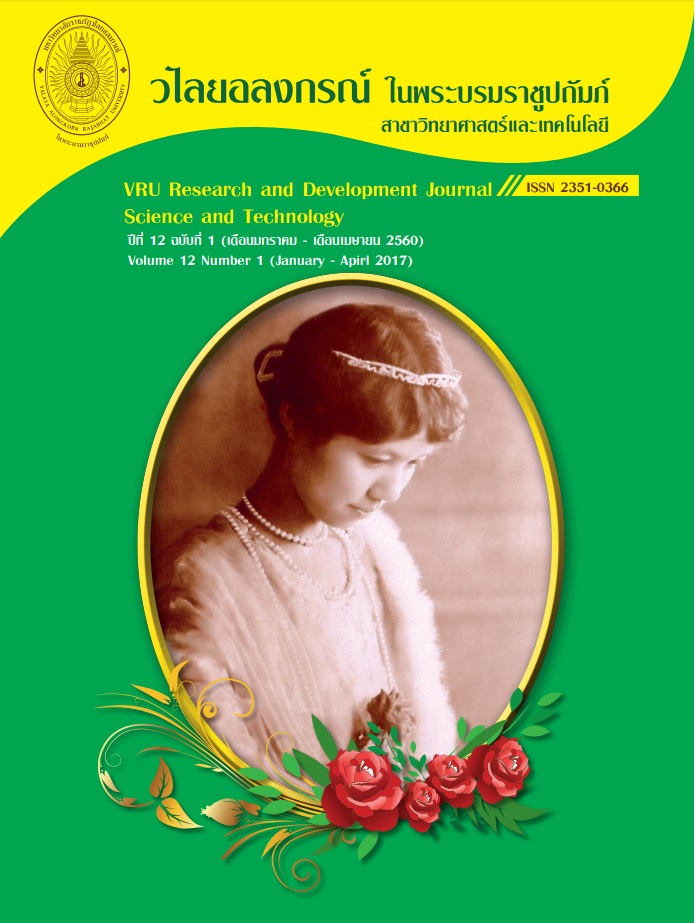Effect of Community and their Inhabitant Activity on Water Quality in Protected Area in Thailand
Main Article Content
Abstract
Three factors come into play when considering agriculture activity and human wastes: (1) Pesticides, fertilizers (2) the waste produced by farm animals and (3) non-existent sewage disposal systems. Human impact on water quality is from density and treatment of domestic sewage. The survey study found that 100% of household have disposed household waste near their resident without treatment. These can cause the depletion of oxygen from water column which can affect to the BOD. Domestic sewage, cattle and other livestock can produce pathogen and microbial contaminate. It can spread infectious disease through contaminate in stream, constituents of concern are E.coli and Fecal coliform. The effect of land management, pesticides from agrochemicals and nutrient from fertilizer and suspended solid from construction and clearing may be harmful and can cause various physical changes. Silt and suspended solid from natural soil erosion, agriculture, road building, deforestation, construction, and other land use change can reduce surface water quality and might be harmful to aquatic animal.
Downloads
Article Details
Copyright Notice
The copyright of research articles published in the VRU Research and Development Journal Science and Technology Journal belongs to the Research and Development Institute, Valaya Alongkorn Rajabhat University under the Royal Patronage. Reproduction of the content, in whole or in part, is prohibited without prior written permission from the university.
Responsibility
The content published in the VRU Research and Development Journal Science and Technology Journal is the sole responsibility of the author(s). The journal does not assume responsibility for errors arising from the printing process.
References
Arnold Jr, C. L. & C. J. Gibbons (1996) Impervious surface coverage: the emergence of a key environmental indicator. Journal of the American planning Association, 62, 243-258.
Brown, G. W. & J. T. Krygier (1971) Clear‐Cut Logging and Sediment Production in the Oregon Coast Range. Water Resources Research, 7, 1189-1198.
Campbell, I. C. & T. J. Doeg (1989) Impact of timber harvesting and production on streams: a review. Marine and Freshwater Research, 40, 519-539.
Dobbie, K., I. McTaggart & K. Smith (1999) Nitrous oxide emissions from intensive agricultural systems: variations between crops and seasons, key driving variables, and mean emission factors. Journal of Geophysical Research: Atmospheres, 104, 26891-26899.
Hem, J. D. 1985. Study and interpretation of the chemical characteristics of natural water. Department of the Interior, US Geological Survey.
Hillel, D. 1991. Out of the Earth: Civilization and the Life of the Soil. Univ of California Press.
Lam, Q., B. Schmalz & N. Fohrer (2011) The impact of agricultural Best Management Practices on water quality in a North German lowland catchment. Environmental Monitoring and Assessment, 183, 351-379.
Lane, P. N. & G. J. Sheridan (2002) Impact of an unsealed forest road stream crossing: water quality and sediment sources. Hydrological processes, 16, 2599-2612.
Luce, C. H. & T. A. Black (1999) Sediment production from forest roads in western Oregon. Water Resources Research, 35, 2561-2570.
Lundqvist, J. (1998) Avert looming hydrocide. Ambio (Sweden).
Mackenzie, C. A., C. A. Chapman & R. Sengupta (2012) Spatial patterns of illegal resource extraction in Kibale National Park, Uganda. Environmental conservation, 39, 38-50.
Meybeck, M. & R. Helmer (1989) The quality of rivers: from pristine stage to global pollution. Global and Planetary Change, 1, 283-309.
Packman, J., K. Comings & D. Booth (1999) Using turbidity to determine total suspended solids in urbanizing streams in the Puget Lowlands.
Peterson, H. G., C. Boutin, K. E. Freemark & P. A. Martin (1997) Toxicity of hexazinone and diquat to green algae, diatoms, cyanobacteria and duckweed. Aquatic Toxicology, 39, 111-134.
Popradit, A., A. Ishida, T. Murayama, T. Srisatit, T. Utarasakul, S. Kiratiprayoon, R. K. Anake & S. Outtaranakorn (2015a) Assessment of Human’s Attitude Towards Natural Resource Conservation in Protected Area in Thailand. Suan Sunandha Science and Technology Journal, 18.
Popradit, A., T. Srisatit, S. Kiratiprayoon, J. Yoshimura, A. Ishida, M. Shiyomi, T. Murayama, P. Chantaranothai, S. Outtaranakorn & I. Phromma (2015b) Anthropogenic effects on a tropical forest according to the distance from human settlements. Scientific reports, 5, 14689.
Reid, L. M. & T. Dunne (1984) Sediment production from forest road surfaces. Water Resources Research, 20, 1753-1761.
Sassen, M. & D. Sheil (2013) Human impacts on forest structure and species richness on the edges of a protected mountain forest in Uganda. Forest Ecology and Management, 307, 206-218.
Ward, M. H., T. M. DeKok, P. Levallois, J. Brender, G. Gulis, B. T. Nolan & J. VanDerslice (2005) Workgroup report: Drinking-water nitrate and health-recent findings and research needs. Environmental health perspectives, 1607-1614.
Zalidis, G., S. Stamatiadis, V. Takavakoglou, K. Eskridge & N. Misopolinos (2002) Impacts of agricultural practices on soil and water quality in the Mediterranean region and proposed assessment methodology. Agriculture, Ecosystems & Environment, 88, 137-146.


